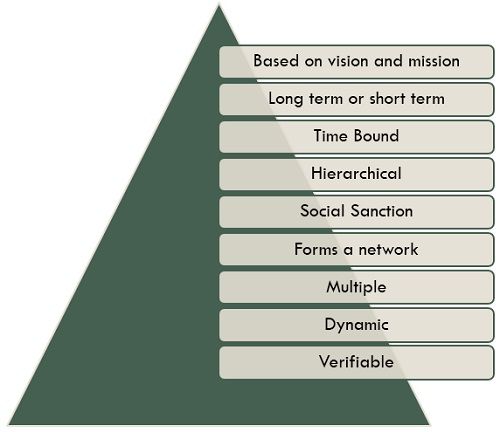Definition: In business terminology, the objective is something that is expected as the end result to be achieved by the firm within a definite period of time, through its operations.
It prescribes the scope and also directs the efforts of the concern. The objectives of the organization are expressed in relation to the future.
It is the fundamental step in the planning process, which are set by the company’s top management while considering the broad and general issues. All the other components of planning, i.e. policy, procedure, schedule, budget, etc. depends on it. It deals with the ‘why’ aspect of planning.
Characteristics of Objectives
The objectives of the firm break down the company’s strategy into a number of achievable targets. The points below will discuss the characteristics of objectives:
- Based on vision and mission: The objectives of the organization are extracted from its vision and mission statement.
- Long term or short term: The objectives of the concern can be long term or short term. For instance, the growth and expansion of the business is a long-range objective whereas sales maximization, and the increase in the margin are considered as short term objectives.
- Time-bound: It is a time-bound desired end, i.e. they must be achieved within the specified time.
- Hierarchical: It has a hierarchy, in the sense that objectives can be arranged according to their importance and priority. Indeed, for each position in the organization, objectives are laid down.
- Social Sanction: It should be created keeping in mind the society’s interest and norms. Hence, it needs social sanction.
- Forms a network: These are interdependent and mutually supportive, however, it does not mean that the achievement of one objective leads to the automatic achievement of the another. Further, it should not be assumed that one objective shall be achieved regardless of the fact that other objectives are achieved or not.
There must be good coordination amidst the activities at the time of planning and its implementation because when the objectives support one another, they can be achieved simultaneously.
- Multiple: The organizations do not exist with a single objective and so every organization has several numbers of objective, which they need to balance so as to run the business effectively. The objectives can be profit generation, customer satisfaction, service to society and nation, market leadership, innovation, development of human resource and so forth.
- Dynamic: They are dynamic in nature as it can be reviewed, modified and replaced according to the circumstances.
- Verifiable: Objectives must be verifiable, i.e. expressed in numerical terms. When the objectives are verifiable they provide standards against which actual performance of the organization and its employees can be measured. However, all the objectives cannot be expressed quantitatively and so in such circumstances, these are expressed qualitatively.
It specifies the future state of affairs, which the organization seeks to achieve and acts as a guide for the entire business planning. Each department, division, levels and unit of the organization may have its own objective. It is in the form of a written statement of the desired ends which can be realised within a given period of time.
Process of Setting Objectives
The process of setting objectives is not an easy one, as the major problem is to set realistic and achievable targets while showing a high level of efficiency. Now we will discuss the process of setting objectives:
- Grouping objectives: The first step to set business objectives is to classify the objectives – Major and derivative objectives. Major objectives are the ones having a wider scope and character, and they are applicable in general. Thereafter these objectives are classified into departmental and individual objectives.
- Reasonableness and consistency: The selected objectives must represent the expectation and intent of the organization, however, it has to be responsible, consistent and attainable. It is a fact that different organizations have different objectives, and each organization has multiple objectives. Hence each objective must be established in the light of another.
- Aspects of objectives: According to experts, there are eight aspects which are to be considered while setting the objectives for performance and result. These aspects are:
- Market standing
- Physical and financial resources
- Innovation
- Profitability
- Productivity
- Manager’s performance and development
- Employees performance and attitudes
- Public responsibility
- Practicality: Objectives have to be established in practical terms and not in idealistic terms. When the objectives are practical it results in job satisfaction and incentives for high performance.
- Balancing the objectives: Short-term objectives are acknowledged as a distinct step to achieve the long term objectives, so as to easily realize the latter. The objectives need to be balanced so as to remove the conflict.
- Change of adjustments: As the business environment is dynamic in nature, so are its objectives and they demand change in terms of time and circumstances. Nevertheless, these are more stable than the other components of the plan. Time by time adjustments is to be made so as to keep pace with the progress.
Conclusion
Objectives are needed in every sphere where the performance and outcome have a direct and significant impact on the company’s survival, growth and market value. The direction, nature and quantum of efforts depend on the objectives solely.

Leave a Reply